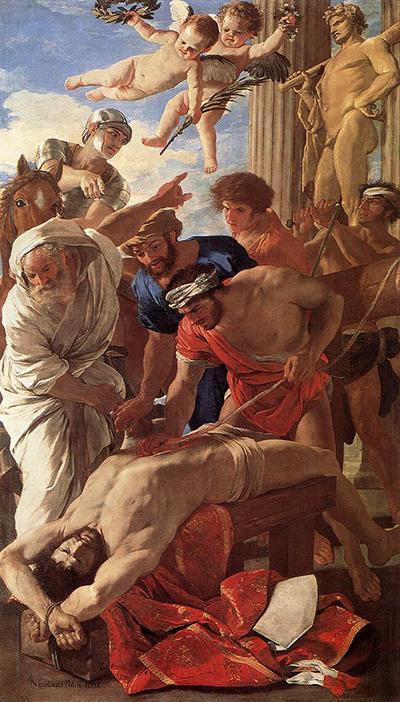The Martyrdom of Saint Erasmus, created in 1628, is an-oil-on canvas painting by Nicolas Poussin that depicts the execution of a Christian during the Diocletianic Persecution. Erasmus, Bishop of Formia, refused to renounce his faith during a time of religious repression and died as a result.
The painting, on display at the Pinacoteca Vaticana in Vatican City, was created at a time of religious unrest in Europe and the theme of martyrdom within the painting could be interpreted as a commentary on the conflicts of the day. The French painter, living in the Papal States, worked on the painting during the civil war between the Protestant Huguenots and Louis XIII’s Catholic forces.
The artwork, measuring 320 cm by 186 cm, portrays the death of Saint Erasmus as he is bound to a wooden bench and eviscerated by a bearded man in one-shoulder tunic. The saint, according to Christian tradition, had survived multiple execution attempts at the hands of the Roman authorities due to the intercession of angels and Poussin may have had these supernatural beings in mind when he painted the two cherubs that hover above the gruesome scene. The presence of the angels, who had saved the victim's life in the past, at the final and fatal execution suggests that the martyrdom was the conclusion of a divine plan.
La Rochelle, stronghold of the Huguenot forces, was besieged from the September of 1627 until the October of 1628 and sailors of the Royalist fleet may have asked Saint Erasmus to intercede on their behalf. It is said that the martyr’s intestines were wound around a windlass, a device used on sailing ships, and this is one of the reasons that Erasmus became the patron Saint of sailors. Warships, loaned from the Netherlands, and a Spanish fleet blockaded the rebellious town that had been supplied from the sea by ships from Protestant England. The painting, while created in Rome, could be interpreted as Catholic propaganda during the Wars of Religion in France.
Francesco Barberini, appointed as a Cardinal by his uncle Pope Urban VIII, commissioned the artwork in the February of 1628 and intended it to decorate an alter in the Erasmus Chapel. Pietro da Cortona, a leading figure in the Baroque movement, had received the original commission but lost it when negotiations over money failed. Poussin, having lived and studied in the Papal States since 1624, received the commission instead of the Italian artist and added his own personal touches to the original plan.




